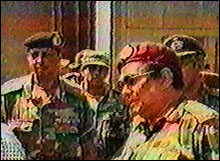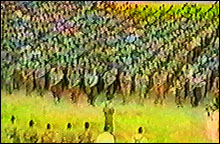
Victory less assured
[TamilNet, Thursday, 13 November 1997, 23:59 GMT]
The Sri Lankan military's largest military operation is 6 months old today. The much vaunted Operation 'Jaya Sikirui' ('Victory Assured' in Sinhalese) was launched on 13 May 1997, with the stated aim of opening a supply route to the SLA's Jaffna garrison, isolated by a broad swath of LTTE held territory. However things are not going as planned.
The Sri Lankan offensive to open a main supply route (MSR) to the Jaffna peninsula was widely anticipated since October last year, when the Sri Lankan army finally wrestled the town of Kilinochchi from the LTTE after fighting pitched battles for two months, losing more than six hundred soldiers and heavy armour.
 |
| Sri Lanka's Deputy Minister Gen. Anuruddha Ratwatte (right) and Lieut. General Rohan Daluwatte in Jayasikurui operation |
An estimated forty thousand Sri Lankan security forces can be supplied only by air and sea now. The Monsoon weather, the LTTE's Surface to Air Missiles and the ferocious attacks of the Sea Tigers continue mount severe pressure on the lines of supply to the north the Sri Lankan government is trying to keep open.
Though the publicly stated objective of Operation Jayasikurui was to secure a supply route to the Jaffna peninsula, the Sri Lankan government had other objectives also. These were
drawing the LTTE into open confrontation and breaking its back through superior firepower, thereby
securing political kudos amongst the Sinhala people and hence
setting the political temperature right to unveil the government's devolution proposals.
Strategic analysts also believe that a secondary objective of the operation was to depopulate the Tamil areas between Vavuniya and the eastern coastline, thereby preparing the way for the expansion of Weli Oya (Manal Aru) further into the northern province. Weli Oya is a military zone where thousands of Sinhalese were settled by the Sri Lankan state after forcibly evacuating the Tamils living there in 1984.
The SLA therefore ignored the easier route to Jaffna along the Vanni's western coast and began preparations for a major operation along the A9 trunk road which runs through the centre of the Vanni.
But LTTE had sufficient time to construct its defences, prepare its military machine and plan for contingencies. The LTTE was also able to devote considerable resources to securing more of the strategic east of the island: from October to April, LTTE units decimated Sri Lankan patrols, overran military outposts in the region.
Things were made much easier for the LTTE as the Sri Lankan army has had to pull out a large number of troops from the eastern province, abandoning in the process several key camps. Military observers agree that the LTTE was firmly in control of 80% of the eastern areas of the island by April 1997.
Furthermore, the Sri Lankan government had inadvertently set a deadline to successfully conclude the war : In early 1997, the government promised the Sinhala public that it would 'end the war' by December 1997. Similarly, in a move to maintain international support for its military onslaughts in the island's northeast, the SL government also promised to deliver the 'political package' by November 1997.
The SLA said it expected to capture the 45 miles of the A9 from Vavuniya to Kilinochchi, within 4 months, before the monsoon set in and turned the mechanised assault into muddy chaos.
The SLA launched Operation 'Jaya Sikirui' (Victory Assured) on 13 May 1997 (the date was chosen as it was said to be auspicious, according to the Sinhala Buddhist calendar). Over 20,000 troops, backed by tanks, artillery and air power pushed into the Vanni region.
 |
| LTTE Units |
The LTTE fought back bitterly. For the first time, the Tigers deployed artillery (captured from the SLA)) and mortars on columns of the Sri Lankan army that were trying to advance on the A9. And Jaya Sikirui stumbled almost immediately. Heavy casualties caused Sri Lankan blood reserves to drop by half within days, prompting urgent appeals for donors.
Stiff Tiger resistance from bunkers and trenches slowed the Sri Lankan advance to a crawl. When the SLA captured the two initial objectives of Omanthai and Nedunkerni towns, the operation was already behind schedule.
As the two columns from Omanthai and Nedunkerni moved towards the obscure village of Puliyankulam in a pincer movement, the LTTE launched its first major counter-attack. LTTE commandos penetrated deep behind SLA lines to smash a major staging area, destroying vast quantities of supplies and killing hundreds of SLA troops. Two other similar (though smaller) LTTE counterattacks inflicted further casualties on Jaya Sikirui later on.
Puliyankulam was meant to be the linking up point for the twin prongs of the SLA assault. The SLA was so sure of its progress that it even went so far as to declare it secured before the troops even reached it.
But LTTE had built very effective defences at Puliyankulam. Straddling the A9 route, the small town was the gateway to further progress along the highway. A few hundred LTTE troops, backed by artillery, beat off repeated SLA assaults for three months, destroying several SLA tanks and inflicting heavy casualties.
Stung by the humiliation, the SLA ignored conventional military strategy of bypassing the village and instead launched ever larger assaults upon it. Many were repulsed. After several weeks, the SLA inched forward to reach Puliyankulam railway station (in the west of the village). The rest of the town is still yet to be secured.
Like the garrison of the Alamo in another war, the Tigers defending Puliyankulam had achieved a significant objective: they had irrevocably delayed their enemy's advance. Jaya Sikirui could no longer be completed on time.
Several belated attempts to bypass Puliyankulam (west of the town) were slowed by LTTE ambushes and counterattacks. Attempts to take Kanakarayakulam, further up the A9 were also repulsed.
After a lull, the SLA decided to secure an alternative route through a little known jungle route that ran parallel to the A9, but further east. Pushing north from its positions along the Puliyankulum-Nedunkerni raid, the SLA reached the Mankulum-Oddusudan road (running east-west).
The Tigers launched a major counterattack on the SLA columns strung out in the jungles east of the A9. In 5 days of heavy fighting, over 500 SLA troops were killed and a massive quantity of arms and ammunition captured (including a million rounds of ammunition). 162 Tigers died in this assault.
The accurate picture of the current situation is difficult to ascertain. Both sides are maintaining a studied silence as to the situation in the Vanni. The Sri Lankan government had banned reporters from the war zones (for several years). What is certain is that the A9 between Puliyankulam and Kilinochchi remains in Tiger hands.
The SLA has said that its troops are occupying 'a line' on the Mankulum-Ottusudan road, and that it is preparing to launch the 'final phase' of the operation. The LTTE says that the isolated SLA camps are under pressure. Meanwhile, LTTE units are slipping into areas recently captured by the SLA and staging guerrilla attacks in the rear.
The heavy monsoon rains lashing the Vanni region have further compounded Jaya Sikirui's problems. The SLA has revised its timetable. It now says it will secure the MSR by February 1998.
It has also raised another division (9,000 men) and thrown it into the Vanni and is stripping the east of the island and even the Jaffna peninsula to beef up the Jaya Sikurui troops. There has been a sudden, corresponding surge in LTTE activity on the peninsula.
Throughout the Jaya Sikirui operation, the LTTE has avoided getting drawn into direct confrontations where the Sri Lankan military can easily deploy superior firepower; except in a handful of decisive counter-attacks where the Tigers have surprised the SLA and prevented it from using its heavy weapons successfully.
By contrast, the LTTE has been able to use been able to effectively deploy 122mm artillery (the LTTE is said to have captured 5 of these) and scores of 120mm and 81mm mortars to slow Jaya Sikirui's advance.
Though the LTTE has lost about 750 troops in the past six months, it has replenished these losses with fresh recruits (although it will be six months before they are sufficiently trained to be deployed in battle). The Tigers have also captured a staggering quantity of arms, ammunition and vehicles from the SLA.
Though the Tigers have lost some ground in the Vanni, they are consolidating their grip on the east. Furthermore, analysts say that even if the SLA opened a supply route to Jaffna, the route will be a very expensive to maintain.
The Sinhala populace has been less than impressed with the government's achievements on the battlefield, despite a concerted PR campaign, complete with suitablly inflated Tiger casualty figures. The Sinhala press has become increasingly critical, and even strongly nationalistic papers have ridiculed the government's battlefield claims.
Military columnists and analysts have been united in their criticism of Jaya Sikiru's approach, results and even objectives.
Desertions continue to plague the SLA and the general sense of malaise has extinguished any interest amongst the Sinhala youth for a military career.
The future of the government's peace package, which has been presented to parliament, hangs in the balance The government is threatening to go to a referendum over the proposals and is hastily trying to mobilise public opinion in its favour, a task hampered by the rising price of essentials (due to taxation to fund the increasingly unpopular war).
In effect, none of Jaya Sikirui's have been achieved six months after it was launched (and two months after it was expected to conclude). The Sri Lankan government however, has staked everything on the success of this operation. It is therefore expected to doggedly back Jaya Sikirui, even though with each passing day, victory seems less assured.









